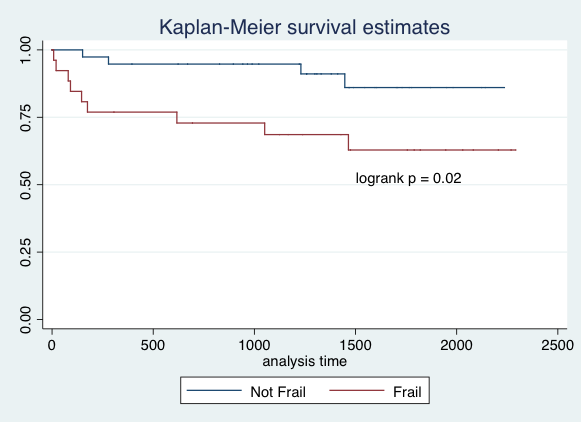Functional Measures of Frailty and Not Sarcopenia Predict Mortality in a Prospective Cohort of Liver Transplant Candidates
Division of Liver Diseases and Transplantation, Columbia Univeristy Medical Center, New York, NY
Meeting: 2019 American Transplant Congress
Abstract number: A311
Keywords: Adverse effects, Liver transplantation, Mortality, Risk factors
Session Information
Session Name: Poster Session A: Liver: Recipient Selection
Session Type: Poster Session
Date: Saturday, June 1, 2019
Session Time: 5:30pm-7:30pm
 Presentation Time: 5:30pm-7:30pm
Presentation Time: 5:30pm-7:30pm
Location: Hall C & D
*Purpose: Sarcopenia determined by single slice measures of abdominal imaging have been correlated with liver transplant (LT) outcomes. However, in end-stage liver disease (ESLD), these body composition measures are not validated and practices vary. Functional measures of frailty, such as the Fried Frailty Index (FFI), may be of value but have not been compared directly to sarcopenia for prediction of mortality.
*Methods: In this prospective cohort study of adults listed for LT, quantified skeletal muscle (SM), visceral (VAT) and subcutaneous adipose tissue (SAT), at L3 on CT/MRI, adjusted for height. Sarcopenia was defined as SM/m2<=38.5 in women and <=52.4 in men. Frailty was defined as FFI >=3. Adipose redistribution was defined as VAT/SAT ratio (VSR). Elevated SVR was defined as > 1.14. VAT and VSR were assessed as predictors of post-LT outcomes with Kaplan Meier and Cox regression.
*Results: 91 patients were analyzed, mean age 56 years, 75% male, 53% had HCV. The median MELD at listing was 14, 71% underwent LT, 13% died pre-LT, 22% died post-LT. The overall median follow-up time was 4 years. Sarcopenia was not associated with frailty (41% v 35%, p=0.59), or individual physical performance measures such as weak grip strength (29% v 71%, p=0.55) or slow walk test (40% v 60%, p=0.52). Sarcopenia was also not associated with pre- (logrank p=0.47) or post-LT mortality (p=0.85). However, frailty was associated with both pre- (p=0.01) and post-LT (Figure, p=0.02) mortality. In addition, patients with frailty had increased length of stay (14 v. 13 days, p<0.01) and infection within 90 days post-LT (68% v. 32%, p<0.01).
*Conclusions: Quantitative measures of sarcopenia must be validated in ESLD, but current measures may be less predictive of outcomes than measures of functional status such as the FFI. In this prospective cohort with 4 years of follow up, frailty is significantly associated with pre- and post-LT mortality, while sarcopenia is not. This highlights the need to better determine the relationship between body composition changes with functional frailty in ESLD and understand their effects on clinical outcomes.
To cite this abstract in AMA style:
Sharma R, Rosenblatt R, Knotts R, Pisa J, Verna E. Functional Measures of Frailty and Not Sarcopenia Predict Mortality in a Prospective Cohort of Liver Transplant Candidates [abstract]. Am J Transplant. 2019; 19 (suppl 3). https://atcmeetingabstracts.com/abstract/functional-measures-of-frailty-and-not-sarcopenia-predict-mortality-in-a-prospective-cohort-of-liver-transplant-candidates/. Accessed December 16, 2025.« Back to 2019 American Transplant Congress

